
WIOCC Group Secures $50 Million to Expand Digital Access Across Africa
WIOCC Group, a provider of high-capacity internet connectivity in Africa, has secured over $50 million in funding from a consortium of international institutions.
The Empower Africa Business Platform is Now Live !!!

The World Bank’s Africa’s Pulse (October 2025) forecasts real GDP growth in Sub-Saharan Africa at 3.8% in 2025, up from 3.5% in 2024.
Growth is expected to accelerate further to 4.4% in 2026–2027, signaling continued—though moderate—momentum in the region’s recovery.
According to the report, 30 of the 47 economies in Sub-Saharan Africa have seen upward revisions in their growth projections since April 2025.
The pickup is largely attributed to easing inflation, rebounding private investment, and improved performance in services and diversified economies.
Inflation across the region continues to decline, falling from a high of nearly 9.3% in 2022 to 4.5% in 2024, with forecasts suggesting it will stabilize between 3.9% and 4.0% through 2025–2026.
This decline has been driven by lower global food and energy prices and improved supply conditions.
As a result, several central banks have begun cautiously easing monetary policy to support domestic demand.
While growth is holding steady, debt vulnerabilities remain elevated.
The report highlights that 23 countries in the region are currently at high risk of or already in debt distress—almost triple the number a decade ago.
External debt service payments have risen sharply, averaging about 2% of GDP in 2024, constraining fiscal space for public investment in infrastructure and social sectors.
Sub-Saharan Africa’s population continues to expand rapidly, with the working-age population projected to increase by more than 600 million people over the next 25 years.
However, only about 24% of new labour market entrants currently secure wage-paying jobs.
The report stresses the need for structural transformation—especially in manufacturing, digital services, and agribusiness—to absorb the growing workforce and capitalize on this demographic momentum.
Growth remains uneven across subregions:
East Africa leads with projected growth above 5%, supported by strong performance in services, tourism, and construction.
West Africa is expected to expand around 4.1%, anchored by Nigeria’s recovery and improved agricultural output.
Southern Africa lags, averaging 2.4%, weighed down by weak industrial output and electricity shortages.
Diversified economies such as Côte d’Ivoire, Kenya, and Senegal continue to outperform commodity-dependent nations.
Sectors driving regional resilience include telecommunications, renewable energy, and transport infrastructure.
The World Bank notes that sustaining growth above 4% will require targeted reforms to enhance productivity, strengthen fiscal governance, and expand access to finance.
Investments in infrastructure, digital connectivity, and human capital are critical to harnessing the potential of Africa’s demographic transition and ensuring economic transformation translates into broad-based prosperity.

WIOCC Group, a provider of high-capacity internet connectivity in Africa, has secured over $50 million in funding from a consortium of international institutions.

Zambian fintech Lupiya has raised $8.25 million in a Series A funding round led by Alitheia IDF Fund, with participation from INOKS Capital SA and the German Investment Bank KfW DEG.

Renew Capital, a leading impact investor focused on Africa’s high-growth enterprises has announced a strategic investment in Zuri, a fast-rising beauty brand determined to transform the African beauty landscape.